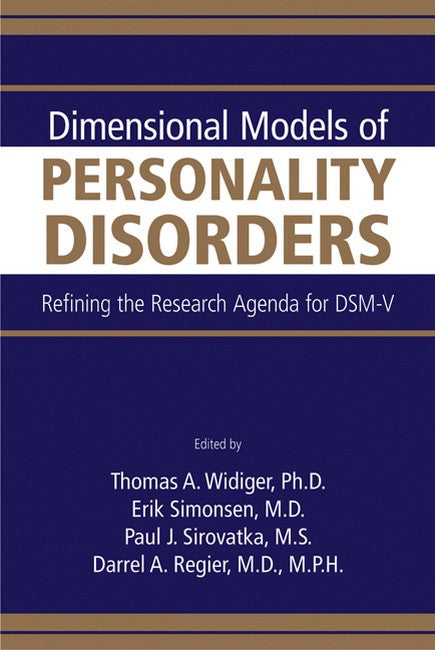ContributorsDisclosure statementForewordPrefaceIntroductionChapter 1. Alternative dimensional models of personality disorder: finding a common groundChapter 2. Commentary on Widiger and Simonsen: toward a consensus personality trait structureChapter 3. Commentary on Widiger and Simonsen: working out a dimensional frameworkChapter 4. Commentary on Widiger and Simonsen: from ICD-10 and DSM-IV to ICD-11 and DSM-VChapter 5. Behavioral and molecular genetic contributions to a dimensional classification of personality disorderChapter 6. Commentary on Livesley: genetic contributions to a dimensional classification: problems and pitfallsChapter 7. Neurobiological dimensional models of personality: a review of three modelsChapter 8. Commentary on Paris: personality as a dynamic psychobiological systemChapter 9. Commentary on Paris: the problem of severity in personality disorder classificationChapter 10. Temperament and personality as broad-spectrum antecedents of psychopathology in childhood and adolescenceChapter 11. Commentary on Mervielde et al.: toward a developmental perspective on personality disordersChapter 12. Personality dimensions across culturesChapter 13. Commentary on Allik: the lexical approach to the study of personality structureChapter 14. Commentary on Allik: a historical perspective on personality disorderChapter 15. Commentary on Allik: cross-cultural diagnosis of personality disorderChapter 16. Continuity of Axes I and II: toward a unified model of personality, personality disorders, and clinical disordersChapter 17. Commentary on Krueger: what to do with the old distinctionsChapter 18. Commentary on Krueger: traits versus types in the classification of personality pathologyChapter 19. Dimensional models: coverage and cutoffsChapter 20. Commentary on Trull: drizzling on the 5 +/- 3 factor paradeChapter 21. Commentary on Trull: just do it: replace Axis II with a diagnostic system based on the Five-Factor Model of PersonalityChapter 22. Commentary on Trull: reservations and hopesChapter 23. Clinical utility of dimensional models for personality pathologyChapter 24. Commentary on Verheul: focusing on the clinician's need for a better modelChapter 25. Commentary on Verheul: clinical utility of dimensional models for personality pathologyChapter 26. Personality disorder research agenda for DSM-VIndex

